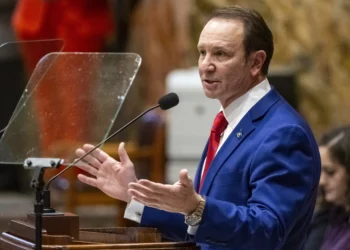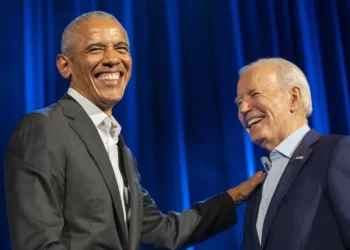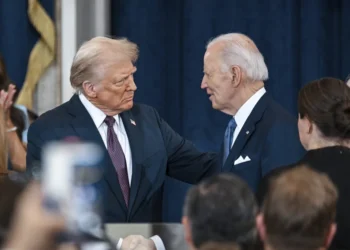Treasury Secretary Scott Bessent is explaining the economic theories that guide President Donald Trump to skeptical audiences, rooting his arguments in growth and abundance amid fears of austerity and recession.
On Monday, Bessent began the Milken Institute Global Conference with a full-throated defense of the Trump agenda.
The day before, Bessent previewed much of his argument with an op-ed in the Wall Street Journal.
In both venues, Bessent sought to weave lower domestic taxation and regulation together with high tariffs into a coherent economic program that can deliver on Trump’s campaign promises.
“Our goal is not simply to grow the economy,” Bessent told the gathering of business leaders and financiers. “It’s to reanchor global capital in the United States and unleash a new age of industrial abundance.”
Bessent compared Trump to the controversial financier who is the conference’s namesake. “Mike Milken, like President Trump, is a visionary,” he said. “In the 1970s, he had the rare combination of guts and intellect to defy the Wall Street consensus. With his heterodox approach to junk bonds, he pioneered a new asset class known today as high-yield bonds.” Years later, Milken was convicted of securities and tax violations, receiving a pardon in Trump’s first term.
“The president recognizes the critical role Wall Street plays in financing the American dream,” Bessent wrote in the Wall Street Journal. “But it’s Main Street’s turn to share in the prosperity. This is the guiding ethos of his bold economic agenda.”
Making the Trump tax cuts permanent and rolling back burdensome regulations remain the administration’s top priorities, but this time paired with a trade rebalancing that exceeds anything that was seriously attempted in his first term.
“The primary components of the Trump economic agenda — trade, tax cuts, and deregulation — are not standalone policies,” Bessent argued in both places. “They are interlocking parts of an engine designed to drive long-term investment in the American economy.”
Most defenders of free markets see Trump’s trade policies as being in conflict with his tax cuts and deregulation. Bessent argues otherwise.
“Tariffs are engineered to encourage companies like yours to invest directly in the United States. Hire your workers here. Build your factories here. Make your products here,” Bessent contended. “You’ll be glad you did — not only because we have the most productive workforce in the world. But because we will soon have the most favorable tax and regulatory environment as well. This is where tax incentives and deregulation come into play.”
Or as Bessent put it in his op-ed, “Tax cuts and cost savings from deregulation raise real incomes for families and businesses. Tariffs provide income-tax relief and create incentives for reindustrialization. Deregulation complements tariffs by encouraging investments in energy and manufacturing.”
This isn’t entirely new. “The opportunity is at hand to jettison a New World Order Americans have rejected in their hearts, to build a new coalition of supply-siders and economic nationalists,” Pat Buchanan declared in 1996. “Marry the growth agenda of Ronald Reagan to the America First philosophy of the four men whose faces are carved on Mount Rushmore — and the future is ours.”
But it was not the majority view among conservatives and libertarians in the years leading up to Trump. It remains hotly contested now, as economists worry that the Trump tariffs will eat away at the economic benefits of the Trump tax cuts. Some fear the uncertainty caused by the former will make it difficult for Congress to extend the latter. Markets have so far been skeptical, and while jobs and inflation numbers have been positive, GDP shrank in the first quarter of the year.
Importantly, Bessent has tried to frame the Trump economic agenda as one of prosperity and abundance. The president himself has begun to talk about sacrifice and scarcity, which tends to be a losing political message.
“I don’t think that a beautiful baby girl needs — that’s 11 years old — needs to have 30 dolls,” Trump said on Meet the Press. “I think they can have three dolls or four dolls because what we were doing with China was just unbelievable. We had a trade deficit of hundreds of billions of dollars with China.”
The treasury chief, by contrast, has stuck to the Golden Age messaging. “The result of the president’s economic plan will be more,” he told the Milken conference. “More jobs, more homes, more growth, more factories, more critical manufacturing plants, more semiconductors, more energy, more opportunity, more defense, more economic security, more innovation. In short, more of all things we need the most.”
Bloomberg reported that conferencegoers approved of Bessent’s sales pitch but remained concerned about chaos and uncertainty.
Trust the plan, Bessent might respond.
ELON’S EXIT: LESSONS IN GOVERNMENT-CUTTING AS MUSK PREPARES TO STEP BACK
“We have uprooted government waste and harmful regulations. We have planted the seeds of private investment. And we have fertilized the ground with fresh tax legislation,” Bessent said. “Next, we harvest. And we want you to harvest with us.”
Both the country and Trump have a lot riding on when and if the harvest comes or whether it is a harvest of despair.

















